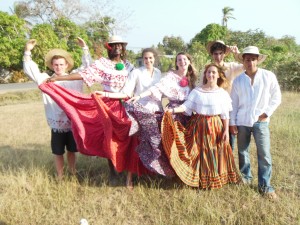We arrived in La Enea, a small town on the Azuero Penninsula, to a lovely welcoming including a whole bunch a excited local children, our new host moms, and the mayor of La Enea, who is one of the homestay dads. Bonnie Birker, our homestay and activities coordinator, was a peace corps volunteer years ago in this small town and has now returned to live here. She has nurtured deep connections with the community which help ease the transition for us and allow very unique opportunities to learn about the richess of the cultural traditions of this region.
 Students went off to have dinner with their families and then we gathered again to see a demonstration of traditional dances in Guararé. What a treat! A couple of us were even brave enough to learn some of the steps.
Students went off to have dinner with their families and then we gathered again to see a demonstration of traditional dances in Guararé. What a treat! A couple of us were even brave enough to learn some of the steps.
This morning the little school bus, driven by Liam’s host mom, picked up each of us from our families. After feeling quite sad about leaving their homestays in Pedasí, the group has felt welcomed in by our new hosts. The bus ride was filled with happy chatter about the new families, including stories of drawing with young host siblings, chatting with new teen sisters, and meeting the iguanas and parrots in the backyard.
We began the day with a tour of Guararé, the neighboring larger town. We walked by the local elementary school, spent time learning about the local library and their efforts to ensure that students in the area have access to books and internet, and saw examples and photos of the traditional polleras – the dresses worn by the “reinas” at the yearly festival. Then we saw a trapiche, the traditional method of drawing out the sweet juices of sugar cane. Lunch was at the home of Rosy, who served us a delicious meal of roasted chicken and fresh herbs, banana cooked to perfection with a hint a vanilla, and rice with fresh, finely chopped vegetables. Our time at Rosy’s included naptime – kids piled on couches and mattresses and any surface they could to catch a very needed siesta (seems like all the moving around is catching up with us.) Afterwards, we were fortified with super sweet and delicious traditional candy that some of us helped prepare called “cocada” – grated coconut with sugar cane honey and condensed milk that is cooked for over an hour and frangranced with vanilla, lemon peel and star anise.
After dessert, we headed to see the final steps of the process of boiling the sugar cane juice into miel back at the trapiche. They pour the juice into a huge metal bowl which has been built into a cob oven and boil it down for hours – very similar to making maple syrup.
Then it was time to try on the traditional polleras ourselves!
